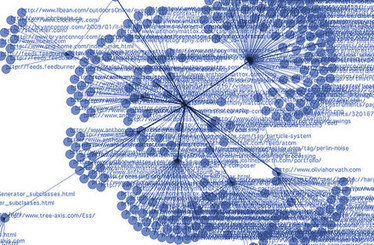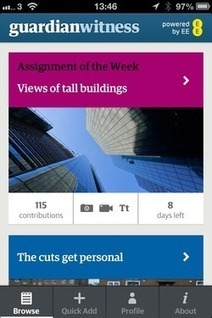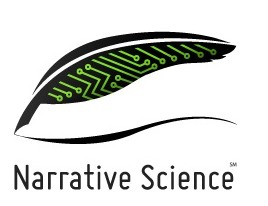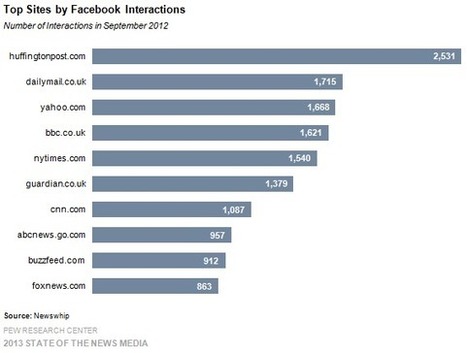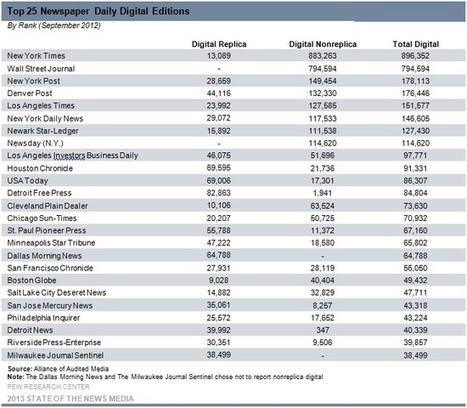 Your new post is loading...
 Your new post is loading...
The media industry may be hurting, but journalism -- and access to information -- is flourishing. Journalists may just have to work smarter, and network more, to keep up.... Journalism is not in crisis. The media industry — and journalists — might be, but the journalism itself is actually improving. Such is the argument made by international documentary filmmaker Bregtje van der Haak and Annenberg professors Michael Parks and Manuel Castells in a recently published article about “Networked Journalism.” As the authors see it, the problem is that most of the doomsayers mix the concept of journalism with the business of journalism. In their article, journalism is defined as the “production of reliable information and analysis needed for the adequate performance of a democratic society.” Not mentioned in the definition are “profits,” “professional journalists” or “traditional publishers.” Just the pursuit of reliable information....
Guardian digital development editor Joanna Geary answers some questions about GuardianWitness.... ...First up: this was built in two months. The sponsorship pot from EE gave them a budget and time to get the job done, but not necessarily have everything they wanted at launch. She says it's a complete, working system that can be built upon. I suggest the phrase "minimum viable product" to Jo but she suggests that it's a full product - one that will be built on. Do they have aspirations for more integration with social media? Yes, they do. And it's something they're looking at as the system develops. The key part of the development which is invisible to us right now is that the Guardian Witness system is deeply integrated with the Guardian's CMS. Once the content has passed through verification, it's available to the journalists, and they can insert it into a story or liveblog just by inserting an URL, which creates an embedded version of the contribution that links back to the contributor's profile. "The really exciting thing is not what you see now, but what you see when Witness is included in a story," she says. It's a tool to facilitate genuine collaborative working between the journalist and external witnesses. Jo says they'll collaborate with people on the ground, or with expert knowledge, in any way they can - and already do, via phone and other traditional methods. This adds another tool for doing that....
Terrible events such as yesterday’s bombings at the Boston Marathon have always meant “all hands on deck” for news organizations, with staffers pulled off their regular beats to contribute. But the endpoint of the newsgathering and reporting is no longer a front-page package of stories explaining — the best one can — what happened, why it happened and what might be next. Now, there is no endpoint — events are reported in real time, with stories in constant motion, and the front page is a snapshot of an organization’s reporting at the moment when the presses needed to roll. Boston was a reminder of that, and a look at what’s changing in real-time journalism. Through Twitter and various live blogs, I found myself looking over my shoulder at the Boston Globe, the New York Times, Reuters and other news organizations, and was able to make some observations and draw some conclusions....
WorldStream, the Journal's stream of brief videos built on Tout, is getting premium ad rates and substantial audience numbers. The text-based web is dead, says Michael Downing. When AOL CEO Tim Armstrong announced his intention this month to transform the company into a platform for video, Downing heard a death knell — one he’s been expecting for some time. We are, after all, as he says, on the precipice of “the rise of the visual web.” Downing has a dog in this fight; he’s the founder of Tout, a video sharing website and app that makes it easy for users to upload and share short — under 15 seconds — videos in real-time. Although originally designed as a consumer device, it also appealed to publishers: The Wall Street Journal approached Downing with the idea for a proprietary app that reporters could use as a news gathering tool. With the addition of some analytics tools and a centralized management function that allows editors to quickly vet clips before they’re published, that became WorldStream, which we wrote about in August....
Alternative weekly colossus Boston Phoenix cracked and fell this week, ceasing publication after 47 years. Once one of the leading alt-weeklies in the nation, the dead paper leaves behind $1.2 million in debt and roughly $500,000 in assets. ...The advertising shift from newsprint to Web is mirrored by a cultural shift. In my mind, the alt-weekly remains the perfect boredom-alleviation device. Waiting for a subway train? Pull one from your bag and it will entertain you. Your girlfriend is late for your date? The paper will keep you occupied. That beer and bag of nuts not distracting from life’s troubles as you mope on a barstool? The alt-weekly saves the day again. But even a human fossil must concede that the smartphone trumps the alt-weekly as a boredom killer. How does a wedge of newsprint compete with an affordable messaging device that ferries games, social media apps, calendars, news, feature films, scores, coupons and a library’s worth of music and reading material? Ask a young person his opinion and he’ll tell you that nothing says “geezer” like a newspaper, be it daily or alt-weekly. What’s changed, and what probably convinced the Phoenix to exit, is that the papers are no longer a 30 percent (or higher) margin business, and that lost business is not returning. Publishers who hope to survive will have to content themselves with 10 percent margins. They will have to work harder to maintain advertising categories where they still have a comparative advertising advantage, such as food and restaurants, which usually require a face-to-face meeting between an ad representative and an owner to make a sale. It’s a cliché, but I’ll toss it out there anyway: Every newspaper and website needs to compete in the events business. The smarter papers are already there, and if they’re lucky they’ll hit the jackpot the Austin Chronicle has with its decades-old SXSW business. And it doesn’t require much insight to urge alt-weekly publishers to continue building out their Web components....
The grizzled vet and the digital native: Journalism has plenty of room for both to succeed. I spent eight years at AOL and I'll say this: I saw none of the great, all of the bad and some of the good. ... The blood sport during my AOL days was about the future of media companies — who would or wouldn’t survive the digital onslaught. Actually, it was much the same during my time at Newsweek in the 80s (who needed three newsweeklies in a broadcast world). Ditto when I joined The New York Times in the 70s (was the city big enough for both The Post and Daily News). Now, the social Web with its echo chamber turns up the volume daily — and makes it more personal, too. It’s far more about the fate of the individual journalist. That quickly gets down to the paycheck. Will there be one? How much? Who gets it — the “professional” or the pretender? Consumer demand for credible news and information is greater than ever. The problem is the 100-year-old model for producing it is forever broken. That’s why more attention must be paid to finding new ways to produce quality journalism — efficiently, at scale and at a price supported by mobile CPMs, which at best are 50% lower than desktop CPMs, which if you’re lucky come in two-thirds lower than print CPMs. In other words, a high-cost newsroom structure built for the print age will never work in a smartphone or tablet world. A few startups are experimenting with new models — Vox Media, Machinima, Bleacher Report and Storify are a few that I follow. Among traditional media companies, FORBES is the only one I know of charting a new course....
|
Traditional news organizations need to embrace the disruption brought by digital culture -- or they risk becoming obsolete. That was the message late last week at the International Symposium on Online Journalism hosted by the Knight Center for Journalism in the Americas at the University of Texas at Austin, where about 370 of the world's journalists, researchers and media watchers grappled with the hard questions for a beleaguered traditional media industry that is now more than a decade into its disruptive transformation. The problem is many media companies view digital technologies through a lens of traditional journalism and thus, fail to strategize properly, said Clark Gilbert, president and CEO of Deseret News Publishing Company. "In a post-disruption world, why would people pick up a paper at all? Why would someone turn on the 10 o'clock newscast?" Gilbert asked. "If you are not asking those fundamental questions, there is not a future for you legacy organization." The key to surviving? Innovate. Fail. Innovate again....
Natural disasters, airline crashes — and yes, terrorist bombs — undercut the normalcy of everyday life by bringing death’s whammy to an unexpected place at an unforeseen time. In the hours and days following such catastrophes, journalists work to restore normalcy to the panicked population by explaining how and why the bad thing happened and how to prevent it from happening again. Reporters have been normalizing the abnormal for so long that they’ve created well-worn catastrophe templates to convey their stories. Yesterday, while covering the Boston Marathon bombing, journalists leaned hard again on those templates. First came the sputtering dispatches over radio and television about the calamity. Next up were the on-the-scene broadcast reports, frequently marred by confusion and contradiction, as the press held out hope for survivors but prepared audiences for the worst. Video of the catastrophe was converted by the cable news networks into a perpetual loop, giving the talking heads a wallpaper background to talk over (and giving new viewers just tuning in something graphic to watch)....
Every 30 seconds or so, an algorithm developed by Narrative Science produces a computer-written news story, Wired reports. The articles run on the websites of respected publishers like Forbes, as well as other Internet media powers (many of which are keeping their identities private). Niche news services hire Narrative Science to write updates for their subscribers, be they sports fans, small-cap investors, or fast-food franchise owners. And the articles don’t read like robots wrote them....
When Facebook introduced its redesigned News Feed, it did more than change how people view memes and photos of cats — it altered the way stories are seen. Now everyone can make news. But for those who make a living by spreading news, Facebook has changed the way stories are presented. Dean Praetorius, a senior editor with The Huffington Post, talked with AllFacebook about how the way news is presented on Facebook requires some changes to the traditional approach. The Huffington Post has recently been lauded for its popularity on Facebook. Pew Research Center presented findings regarding news and social media, citing a study by Newswhip showing that the online newspaper was by far the most engaged news source on Facebook. In terms of Facebook interactions, HuffPost beat out more traditional companies, such as The Daily Mail, The New York Times, and CNN. How did HuffPost accomplish this? Praetorius said that the company has taken a well-rounded approach to social media, knowing that the story is far from completed when it’s published. HuffPost also thinks about stories differently from print media outlets and TV stations. Praetorius said that stories on the site are meant to generate conversation, and not so much to simply inform, as an old-school newspaper would...
If the newspaper industry had theme music in 2013, it might use “Been down so long it looks like up to me,” the much-recycled line from a 1920s blues song. For the first time since the deep recession that began in 2007, newspaper organizations have grounds for a modicum of optimism... Companies have started to experiment in a big way with a variety of new revenue streams and major organizational changes. Some of the bright opportunities – such as offering social marketing services to local businesses – are ventures too new to be measured yet industry-wide. They show signs of stabilizing revenue.... Even halting improvement in the general economy helps the industry. The double whammy of cyclical ad losses on top of secular shift to new media has considerably eased from the worst of the recession from 2007 to 2010. Auto advertising has come back, and some markets, like Miami, are beginning to see recovery in real estate and employment ads as well. All those positives, however, are for the time being mostly promise rather than performance. The most basic indicators have not turned around. The industry is little more than half the size it once was. Considerable dangers persist... So the industry entered 2013 with some positive signs but still dealing with difficult economic realities. The two biggest newspaper developments of the last year – digital paywalls and reduced print frequency – capture that odd mix of expansion and contraction now typical within the industry....
|
 Your new post is loading...
Your new post is loading...
 Your new post is loading...
Your new post is loading...




